Tuesday 18 May
 |
| Flamingos Phoenicopterus roseus at Navaseca |
Monday morning and up to Frigiliana by 9.30 to collect friend Steve Powell for our visit to Daimiel in the Ciudad Real province of Castilla la Mancha. The weather was set fair and, indeed, promised to be hot and clear so a short stop at the lake at Padul, half way between Salobrena and Granada, to check out what might be about. A little disappointing to arrive and fins both a very large and smaller coach in the car park but, fortunately for us, most of the young children were enjoying the entrance picnic area. off through the trees and immediately both Reed Warbler and Nightingale along with Blackbird and Wood Pigeon. By the time we had reached the end of the following boardwalk we had also recorded a Mallard, Cetti's Warbler and small flock of Waxbill. A pair of Blackcaps were seen and above us a pair of circling Booted Eagles. A few Goldfinch, Spotless Starlings and many Common Swifts before the first Magpie of the morning. Overlooking the reedbed from the raised platform we were also to observe a quartering Marsh Harrier. Just time for a quick circuit of the site in the car picking up both Great Tit and Crested Lark before on our way to Daimiel with a stop for lunch once inside Castilla la Mancha. Also seen n the journey were Griffon Vulture, Kestrel and a Raven along with many Magpies and Wood Pigeon.
 |
| Marsh Harrier Circus aeruginosus quatering Padul |
Arriving in Daimiel it was straight to the Laguna Navaseca where there seemed to be more water than last year. From the top car park we could see scores and scores of feeding Common Swifts with, on and over the water, many Black-headed Gulls, a good number of Whiskered Tern and the expected scores of Flamingos. Ducks included Common and Red-crested Pochard, Mallard, Shelduck and very many White-headed Ducks. Naturally there were Black-winged Stilts, Coots and Moorhen plus a plentiful supply of both Little and Black-necked Grebes plus the occasional Great Crested Grebe. This lake is well-known for its breeding Greylag Geeses and in this we were not to be disappointed.
 |
| Coot Fulica atra |
Moving on to the roadside hide at the far end of the lake we had our first Serin and noticed the small amount of water in the pool on the opposite side of the road. here we were to find a handful of Glossy Ibis and Black-winged Stilts along with a quartet of Redshanks, Common Sandpiper and both Ringed and Little Ringed Plovers. Checking the main pool on the opposite side of the road we noticed the Avocets, Great Reed warblers and even heard a couple of Savi's Warblers. A Little Tern paid a visit to the area and soon we were off to check the remaining hides before taking the track alongside the back of the water where we also added Corn Bunting, Sardinian Warbler, Cetti's Warbler and very many more White-headed Ducks. It was rom one of these later hides that we saw our first Marsh Harriers and only Little Egret of this visit. Our final bird of the visit before rejoining the main road was a Bee-eater where we came across a trio resting on the wires at the edge of a vineyard.
 |
| Flamingos Phoenicopterus roseus by the score |
Time to head off and check into our countryside hostal for the evening and witness the marvellous surroundings of what looked like a massive hacienda set in rolling countryside with wandering Peacocks and Guinea Fowl. All settled in and overnight cases deposited we decided on an early evening visit to the Tablas de Daimiel some twenty minutes away.
 |
| Far more water at Navaseca than Tablas de Daimiel |
Approaching the main water we stopped to note the Greylag Geese on the river, the White Storks on and around their nests before parking at the entrance to the reserve where major works were being undertaken to, presumably, create a very large, organised car park. Entering, we discovered that in order to minimise personal contact with others there was now a one-way, anti-clockwise trail. Being very ate in the afternoon we were not expecting to see more than the occasional visitor so happily wandered along seeing Collared Dove and Corn Bunting and listening to the many, very vocal, Nightingales. This initial track took us to the hide overlooking the recovery lake which held Wigeon, Garganey, Pintail, Red-crested Pochard, Ferruginous, Tufted and White-headed Duck, as well as the nesting Barn Swallows actually inside the hide, before moving on towards the outward boardwalk.
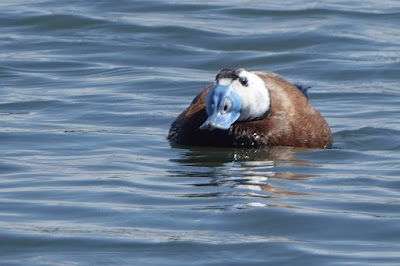 |
| White-headed Duck Oxyura leucocephala (male above and female below) |
Once on the boardwalk and in the reeds we were, literally, being deafened by the singing Great Reed Warblers along with Reed and Savi's Warblers. Lots of Magpies and Wood Pigeons about and having discovered how little water there was, it being completely dry once beyond the first, relatively small pool, we made our way round to the far boardwalk and back to the original pool. Here, many more warblers of Reed, Great Reed and Savi's persuasion along with a lovely male Reed Bunting. A couple of pairs of Coot both had three chicks and were bust feeding the small beaks. Then making our way back to the car park both Blackbird and Glossy Ibis overhead along with calling Hoopoes and a solitary Spotted Flycatcher in the old trees just opposite the car.
 |
| Coot Fulica atra with one of its three chicks |
Time to stop for some liquid refreshment at the small bar near the former water mill having just passed a trio of departing Red-legged Partridge and whilst sitting outside enjoying our drinks we watched the local House Sparrows, Crested Larks, Magpies and White Storks we noticed the handsome male Marsh Harrier to our left and a trio of Squacco Herons flew in overhead on their way to , presumably, their evening roost on the river behind. And so to bed in readiness for an early departure come the morning.
 |
| White Stork Ciconia ciconia |
Up and out of the hostal just after daybreak so that we arrived back at the Tablas de Daimiel by 7.15. On leaving the front door a Blackbird was flying across the car park, Collared Dove calling from the tree on the left and above us a Golden Oriole singing from the nearest tree. As we approached we noticed a Little owl resting on top of a small farm hut and arriving in the car park the usual assortment of Spotless Starling, House Sparrow, Wood Pigeon and Magpies. First to arrive, and suddenly discovered having come dressed for yesterday's hot weather that the temperature was only 11C so really need the hot sun to warm us up as soon as possible!
 |
| Reed Bunting Emberiza schoenicius (Male above, female below) |
Working our way straight to the boardwalk to pick up the anti-clockwise track having, as we passed the old mill area, watched a pair of Carrion Crows crossed the mall trees just above our heads, a most unexpected and pleasant surprise. In addition, White Storks on our left and right and a few Greylag Geese resting below us on the left. Immediately we could hear numerous Nightingales and a few Great Tits before reaching the reeds where upon our senses were blasted by the raucous calling of the Great Reed Warblers along with an undercurrent of Reed and Savi's Warblers. It soon became obvious that here were plenty of Linnets about and the males looking particularly handsome in their red breeding waistcoats.
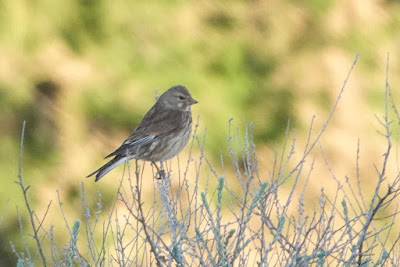 |
| Female Linnet Carduelis cannabina |
A Great White Egret flew from the right in front of us and then a trio of Red-legged Partridge made a hasty departure. Barn Swallows were flying overhead as we reached the first water which produced both Common Pochard and Mallard. Having watched a pair of Flamingo fly over we then noticed the trio of Black-winged Stilts to our left and a distant Marsh Harrier. Next over from the direction of the river a couple of Night Herons whilst the Coot fed their young and all accompanied by the constant calling of Hoopoes.
 |
| Corn Bunting Emberiza calandra |
No sooner had we stated again and we were at the platform overlooking what we think of as the Bearded Tit area. Lots of both Reed and Great Reed Warblers but, eventually, a couple of brief sightings of female Bearded Tits. At this point a distant flight of Glossy Ibis from the direction of the river plus a pair of Greylag Geese whilst foraging in the reeds was a Blue Tit and more Linnets. On towards the old, stone croft and a real pleasing surprise as a Roller flew from left to right in front of us. Once in the hilly meadow with its mass of red flowers, more and more Linnets, House Sparrows and Crested Larks along with a few Tree Sparrows. Whilst at the top near the mirador a cattle Egret flew past and it was obvious that the river below must have been the overnight roosting area for the egrets and herons, especially as a Grey heron was still present.
 |
| Great Reed Warbler Acrocephalus arundinaceus |
Working our way onwards the first of many Corn Buntings which seemed to enjoy occupying every tall, single tree. A single juvenile Stonechat remained stationary for a long time then the loud calling of Cetti's Warblers. More Marsh Harriers to our right near the river and a Spoonbill, or maybe two, flew in towards said water. back, eventually, to the boardwalk we now continued round to the back of the original pool and spent much time watching at the Linnets and Great Reed Warblers as we tried to photograph both Savi's and Reed Warbler. A quartet of Purple Heron flew over and returned to settle down in the reeds to our left. On the water in front both Common Pochard and Mallard plus also a pair of Gadwall. An Avocet flew in and then we concentrated on the Reed Buntings. In front of us suddenly a pair of Iberian Yellow Wagtails which later returned to pose on the reeds to our advantage.
 |
| Purple Heron Ardea purpurea |
Once the Gadwalls had moved on and been replaced by a pair of Shelduck we made our way back towards the car park finding Goldfinch, Greenfinch, Red-rumped Swallow and a number of Common Swifts. Indeed, it seemed quite out of place to suddenly have a single Black-headed Gull above us! Now it was a case of a very hurried return to the hostal to be in time for breakfast which was only served till 10.30 and then pack up and make our departure.
 |
| Gadwall Anas strepera |
By 11 o'clock we were back on the road and decided to make a further, short stop at the Tablas before finally saying our goodbyes at the Laguna de Navaseca. This time it was straight to the far board walk to spend more time trying to catch good sightings of the ever-present Savi's Warblers, albeit the Great Reed Warblers refused to remain either hidden or quiet. Lovely to continue to see Nightingales, Reed Buntings and Linnets along with both Reed and Great Reed Warbler, Savi's Warbler, Common Swifts and Barn Swallows but the time finally came to move on to the Navaseca.
 |
| Female Mallard Anas platyrhynchos with ducklings line astern |
This time we entered form our previous exit track to travel in reverse order and had soon observed Crested Lark, Goldfinches and Serin. Once in sight of the water scores of Flamingo and Black-headed Gulls along with so many duck species, especially White-headed Duck, but also Shoveler, Common and Red-crested Pochard, and Shelduck. Both Little and Black-necked Grebe were still present along with the scores of Common Swifts and many Barn Swallows. Certainly no shortage of Coots but just the single Moorhen. Add on Little Egret, Avocet and Greylag Geese and the you began to wonder how all the water birds managed to find enough space never mind food! For Steve and the visiting Spanish birder it was the trio of Marsh Harriers that seemed to capture the most attention.
 |
| Marsh Harrier Circus aeruginosus at Navaseca |
Finally, back at the little pool at the side of the "main" road it was obvious that the last of the water would be gone within a day or two if no more rain but still a handful of Glossy Ibis present along with Black-winged Stilt, Redshank, Common Sandpiper and Ringed Plover. And, as you might expect, out of the reeds the continuous calling of Savi's, Reed and Great Reed Warbler. Time to make our way all the way back to the Andalucian coast.
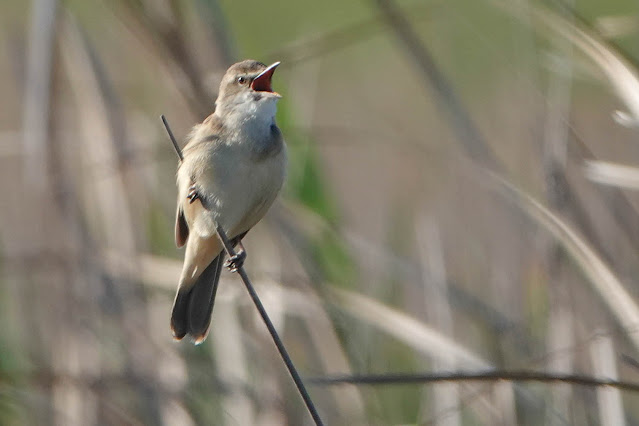 |
| That Great Reed Warbler Acrocephalus arundinaceus continues to sing |
At last we found a couple of Buzzards as we made our way south and so, eventually back to Frigiliana where we were welcomed by the first House Martins seen these past two days and Steve was able to rejoin his wife. But not just House Martins. As with first thing this morning, on getting out of the car a Golden Oriole was singing from the tree opposite. Home for me in Mezquitilla where I was welcomed by the first Pallid Swifts and Monk Parakeets seen since last week-end and as I parked the car behind the house I looked up to see the "missing" White Wagtail foraging on the road. A great visit, great weather and enjoyable company which finally resulted in a total of 87 species.
 |
| Glossy Ibis Plegadis falcinellus with Black-winged Stilts Himantopus himantopus |
Birds seen:
Greylag Goose, Shelduck, Wigeon, Gadwall, Mallard, Pintail, Shoveler, Garganey, Red-crested Pochard, Common Pochard, Ferruginous Duck, Tufted Duck, White-headed Duck, Red-legged Partridge, Little Grebe, Great Crested Grebe, Black-necked Grebe, Night Heron Squacco Heron, Cattle Egret, Little Egret, Great White Egret, Grey Heron, Purple Heron, White Stork, Glossy Ibis, Spoonbill, Flamingo, Griffon Vulture, Marsh Harrier, Booted Eagle, Buzzard, Kestrel, Moorhen, Coot, Black-winged Stilt, Avocet, Little Ringed Plover, Ringed Plover, Redshank, Common Sandpiper, Black-headed Gull, Little Tern, Whiskered Tern, Wood Pigeon, Collared Dove, Monk Parakeet, Little Owl, Common Swift, Pallid Swift, Bee-eater, Roller, Hoopoe, Crested Lark, Barn Swallow, Red-rumped Swallow, House Martin, Blue-headed Wagtail, White Wagtail, Nightingale, Stonechat, Blackbird, Cetti's Warbler, Savi's Warbler, Reed Warbler, Great Reed Warbler, Sardinian Warbler, Blackcap, Spotted Flycatcher, Bearded Tit, Blue Tit, Great Tit, Golden Oriole, Magpie, Carrion Crow, Raven, Spotless Starling, House Sparrow, Tree Sparrow, Waxbill, Serin, Greenfinch, Goldfinch, Linnet, Reed Bunting, Corn Bunting.
More photographs from Daimiel:
 |
| Bee-eater Merops apiaster |
 |
| Avocet Recurvirostra avosetta |
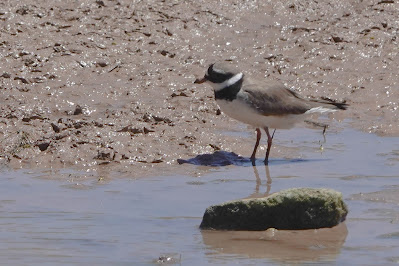 |
| Ringed Plover Charadrius hiaticula |
 |
| Black-necked Grebe Podiceps nigricollis |
 |
| Iberian Yellow Wagtail Motacilla flava iberiae |
 |
| Common Sandpiper Actitis hypoleucos |
 |
| Curlew Sandpiper Calidris ferruginea |
 |
| Common Redshank Tringa totanus |
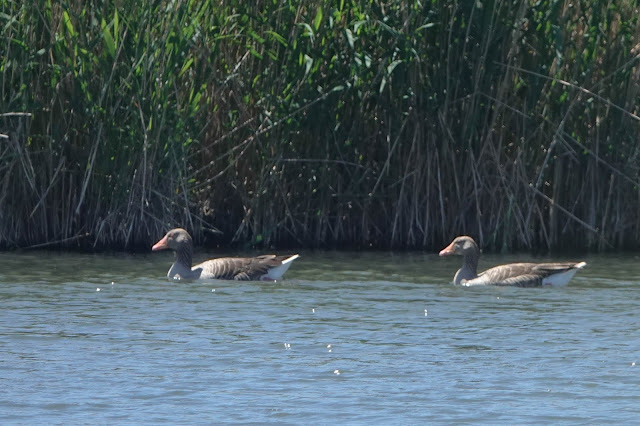 |
| Two of the many Greylag Geese Anser anser |
 |
| The many remaining Poppies Stylophorum still make a lovely sight on the bank of the meadow |
Check out the accompanying website at http://www.birdingaxarquia.weebly.com for the latest sightings, photographs and additional information































No comments:
Post a Comment